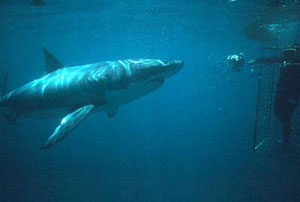 Benchley's book and Spielberg's classic film Jaws might well have been set off San Francisco, in that although shark attacks are rare events, the fear and publicity associated with sharks off central California is on most everyone's mind.
Benchley's book and Spielberg's classic film Jaws might well have been set off San Francisco, in that although shark attacks are rare events, the fear and publicity associated with sharks off central California is on most everyone's mind.
The White shark (Carcharodon carcharias), also known as the Great White Shark, requires no hyperbole. It is the only shark species in California that presents a significant danger to humans. White sharks live worldwide in cool, coastal waters. Interactions between humans and sharks happen each year and within the "Red Triangle" (a 100 mile stretch of coast running from Bodega Head to the Farallon Islands to the south end of Monterey Bay) there have been 48 white shark attacks since 1952. With increasing use of the coast by swimmers, surfers, abalone divers, kayakers, and windsurfers, the risk of attack will increase unless users become aware of the natural and unnatural history of the White shark.
Research accomplished by scientists at the California Academy of Sciences, as well as by researchers from the Point Reyes Bird Observatory, the Monterey Bay Aquarium, and the University of California at Davis, has significantly increased our knowledge of white shark biology, allowing us to better predict their risk to human safety and to demonstrate the important ecological role that sharks play within our coastal waters.
Adult White sharks feed primarily on pinnipeds (seals and sea lions) and typically stalk their prey from behind and beneath before attacking -- in most cases, neither pinniped nor people see the shark before it bites them. The initial bite is so rapid and so forceful (adult White sharks weigh as much as 1-3 tons) that the victim is often lifted from the water and then released, after which the shark typically waits for the victim to bleed to death before attempting to consume it.
White shark attacks upon humans typically occur nearshore in water 10-30 feet deep, placing swimmers, snorklers, surfers, kayakers, and scuba divers (when at the surface) at greatest risk. The appearance of a surfer on a short board, for example, might easily be mistaken by a hungry shark for a basking sea lion. White sharks can see color, have quite good vision, and rely on that sense to spot their prey. They do not appear to discriminate coloration in that they usually look skyward before an attack and only observe the surface silhouette of the victim.
